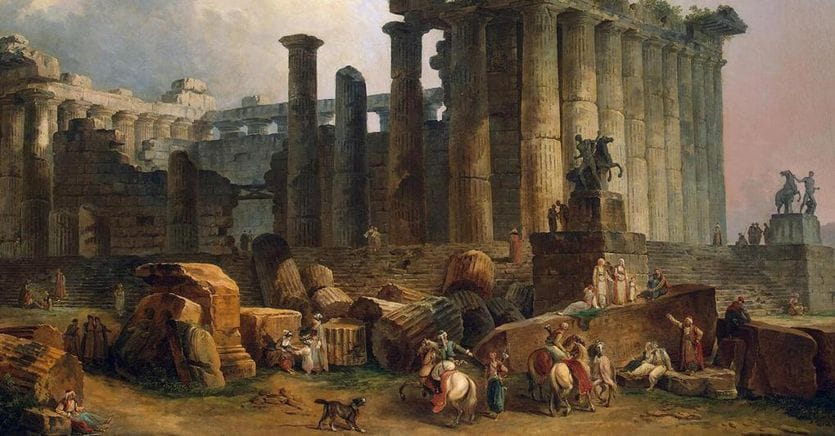In the essay on the German Baroque drama (Origin of the German tragedy, 1928), Walter Benjamin writes that “allegories are in the field of thought, what ruins are in the field of things”. With this icastic definition, the German thinker exemplarily summarizes the reasons why the ruins have represented one of the most powerful metaphors of Western culture. Ruin is a constant presence in culture from classical antiquity to the contemporary age, what changes is the perception: the oscillation between death and life, between oblivion and memory, decadence and rebirth belongs to a relatively modern conception of ruins that dates back to at the time of the Industrial Revolution.
The old world
Progress and modernity generate the fear that the old world, with its values, may suddenly disappear. In this context, the ruin becomes a cultural anchor, the keeper of memories, therefore itself a memory to be preserved and preserved. But the ruin is not only vestige and materiality, it also acts through immateriality.
Loading…
If we observe it from a historical-cultural perspective, the meaning of the ruin extends over a very wide spectrum of disciplinary fields, it crosses completely different eras and cultures and only a titanic undertaking could allow us to face the multiple faces of this polyhedron.
Alain Schnapp
The French scholar Alain Schnapp has dedicated himself to it, who has poured the result of more than ten years of research into the monumental volume A universal history of ruins. From the origins to the Enlightenment, an impressive work in terms of density, illustrative apparatus, format and above all impressive erudition. Former historian and archaeologist of ancient Greece at the Sorbonne, tireless animator of the Center Louis-Gernet, one of the founders and first director of the Institut National d’Histoire de l’Art, raised at the school of Pierre Vidal-Naquet and Jean-Pierre Vernant ( the volume is dedicated to the latter), polyglot, fellow of the main world research centers, equipped with a vast culture, Schnapp had everything in his baggage to succeed in this extraordinary and sumptuous book, a true “narrative forest” that is inscribed in the register of a universal history.
Chateaubriand
The volume opens with the Genius of Christianity by Chateaubriand, considered by Schnapp to be the creator of a hermeneutic of ruins: «Man himself – writes Chateaubriand – is nothing but a fallen building». However, this desperation does not prevent him from identifying the three fundamental oppositions that structure the idea of ruin: materiality and immateriality, nature and culture, memory and oblivion – oppositions that run through the entire work. The volume has the structure of a modern one Hypnerotomachia Poliphili, with the reader in the guise of a modern Polyphilus who ventures into a journey through time and space: in his itinerary he meets Mesopotamian and Egyptian rulers, engaged in the search for ancient monuments and inscriptions to anchor themselves to their predecessors in continuity of the past. In the Greek world, the discourse on ruins is linked to the formation of heroic cults, which arose around the monumental presences of the Mycenaean age, perceived in the Archaic age as belonging to a mythical world. For the Romans they were a material image of destiny, an absence without the possibility of redemption, always assimilated to a desert landscape, evoking death.
